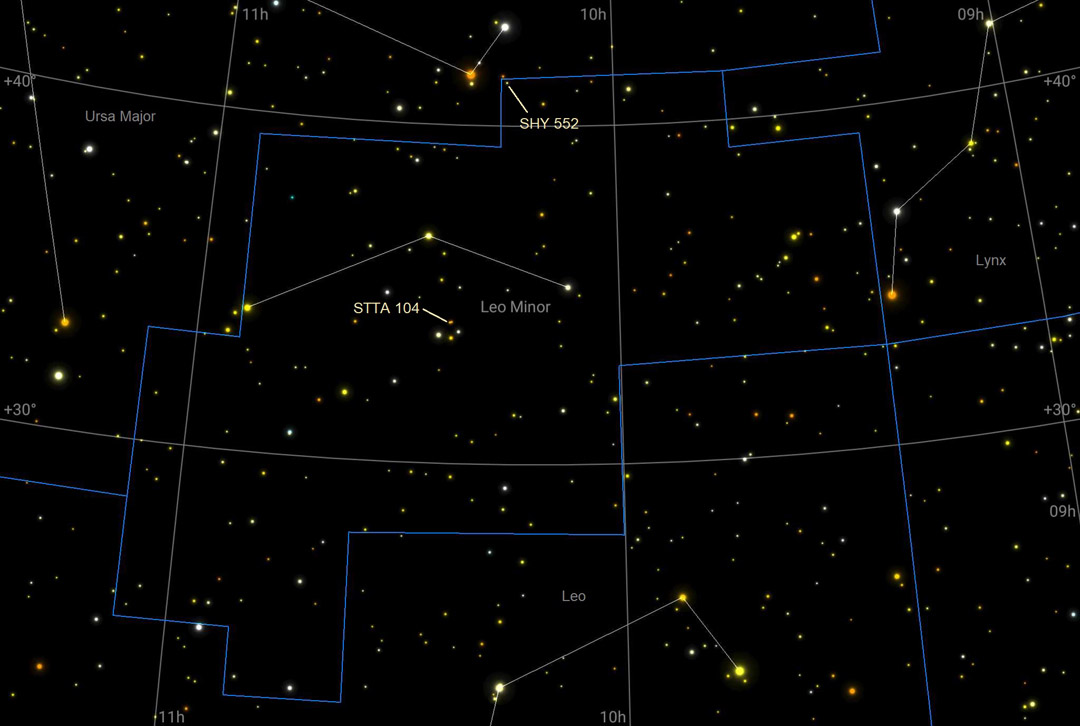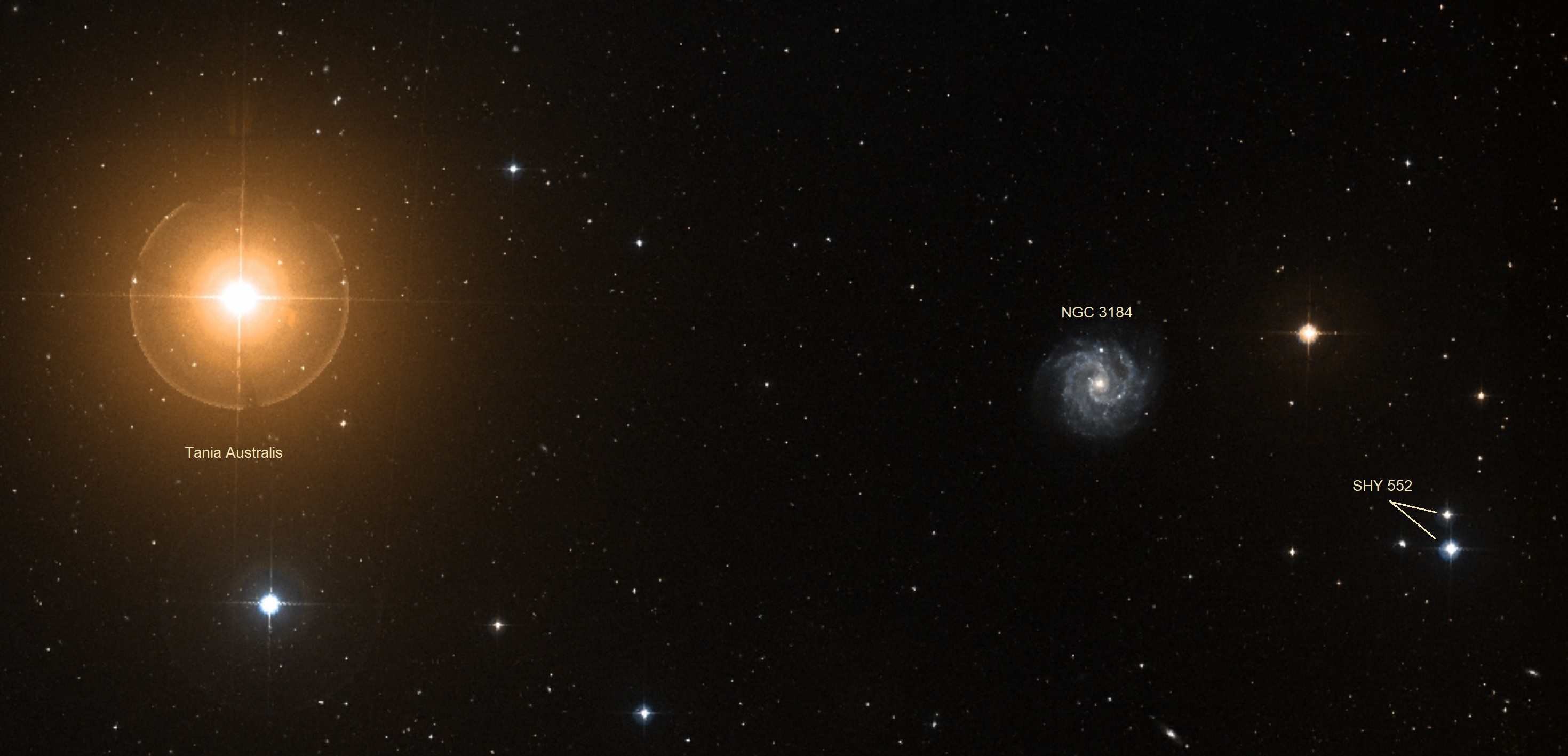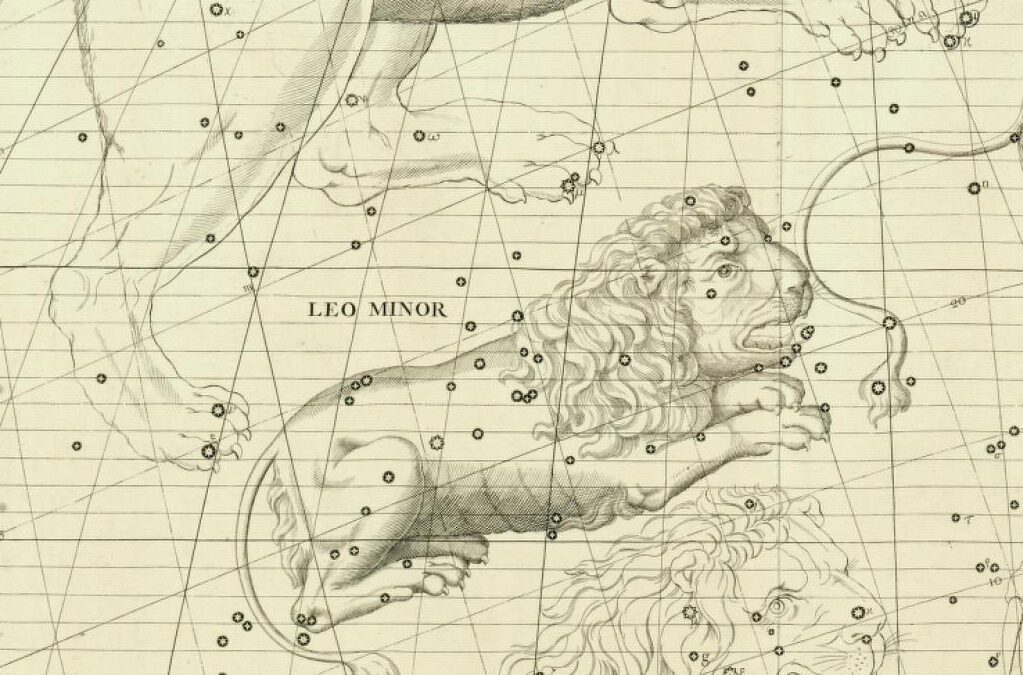A few weeks ago I was consulting Sky Safari and StelleDoppie to identify objects of binocular interest in Leo Minor and found a likely double star in the upper northwest corner of the constellation boundary with Ursa Major, near Tania Australis. Only a WDS code (no discoverer code) was included in the Sky Safari listing. Hmmmm. I searched StelleDoppie for the HD catalog number (HD 88959), and came up with the irresistible discoverer code SHY 552. What could be better for a modestly bright double star in an inconspicuous constellation? The above image is a detail from the Leo Minor and Lynx plate in the Atlas Coelestis of John Flamsteed, published in 1729. The source is an exhibit of the Special Collections of the University of Michigan Shapiro Science Library — Divine Sky: The artistry of Astronomical Maps.

SHY 552 (HIP 50325/50327)
10h16m +41*17′
7.40/8.78 sep 106.9″ pa 6
Physical double star.
Distance: 176.8 / 178.14 light years
Spectrum: F5 / F8
Color-index: +0.46 yellow-white / +0.60 yellow
A fun and pleasing double star in instruments from 10×50 to binocular telescopes. The primary is warm white. The secondary is sand colored and obviously fainter than the primary. Observation made with 82XL-SD and Pentax 20mm XW eyepieces (22.5x).

Shy 552 is shown here in a glorious field with Tania Australis and the face on spiral galaxy NGC 3184 which cannot be observed with binoculars from a light polluted sky but is likely to be visible (as a faint nebulosity) from darker sites. I have added it to my dark sky site observing list. If it ever stops raining…
The discoverer code appears to be that of Dr. Ed J. Shaya, an associate research scientist in the Department of Astronomy at the University of Maryland. StelleDoppie lists 228 entries with the SHY code, possibly stars identified in a statistical analysis of Hipparcos data described in an article published by Dr. Shaya and another UMD scientist, Dr. Rob P Olling, in the December 2010 issue of the Astrophysical Journal Supplement Series. The abstract of the article states that it “is the first all-sky survey to locate escaped companions still drifting along with each other.” So the stars may no longer be gravitationally bound. And they typically have considerable separations. SHY 552 seems to be one of the closer pairs. 🙂 Olling’s home page includes a Very Wide Binaries section that has a reference to the above article and others. Many of the StelleDoppie entries, which are derived from the Washington Double Star database, list separations of 999.90, presumably because the separations are more than 1000 arc-seconds and the WDS separation field is limited to values less than that.

Another binocular object I truly enjoy in Leo Minor is the double star STTA 104 and its attendant bright asterism trio of 30, 28, and 27 LMi. In addition to providing a beautiful view, it is also a distinct and useful navigation aid for exploring the constellation. Shown above in a colored Digital Sky Survey image from simbad.
STTA 104
10h24m +3411′
7.21/7.27 sep 209″ pa 287
Uncertain nature
Distance: 1206.69 / 1368.62 light years
Color Index: +1.44 Orange / +1.61 Orange-red
Spectrum: M4/6III, giant / K0
Luminosity: 130x Suns (visual) / 104x Suns (visual)
Diameter: 85.6x Suns / ??
Saturday 13 May 2023
Oberwerk 82XL-SD+20XWs
The primary (which is UU LMi) is the more orange of the two stars. I would describe it as a yellowish orange whereas HD 90024, the secondary, is more of a deep yellow color. A lovely and wide double star, suitable for lower magnification binoculars and easily resolved with hand held instruments.
Here are the colors I recorded for the three bright asterism stars (from left to right).
- 30 LMi – White
- 28 LMi – Light yellow
- 27 LMi – White
These stars are 200-400 light years distant, much closer than the double star.


Thank you for another great blog. The objects you highlight are wonderful additions to my nightly observing lists.
Thank you, TJ! 😁